REVISITING PENANG'S TUMULTUOUS PAST
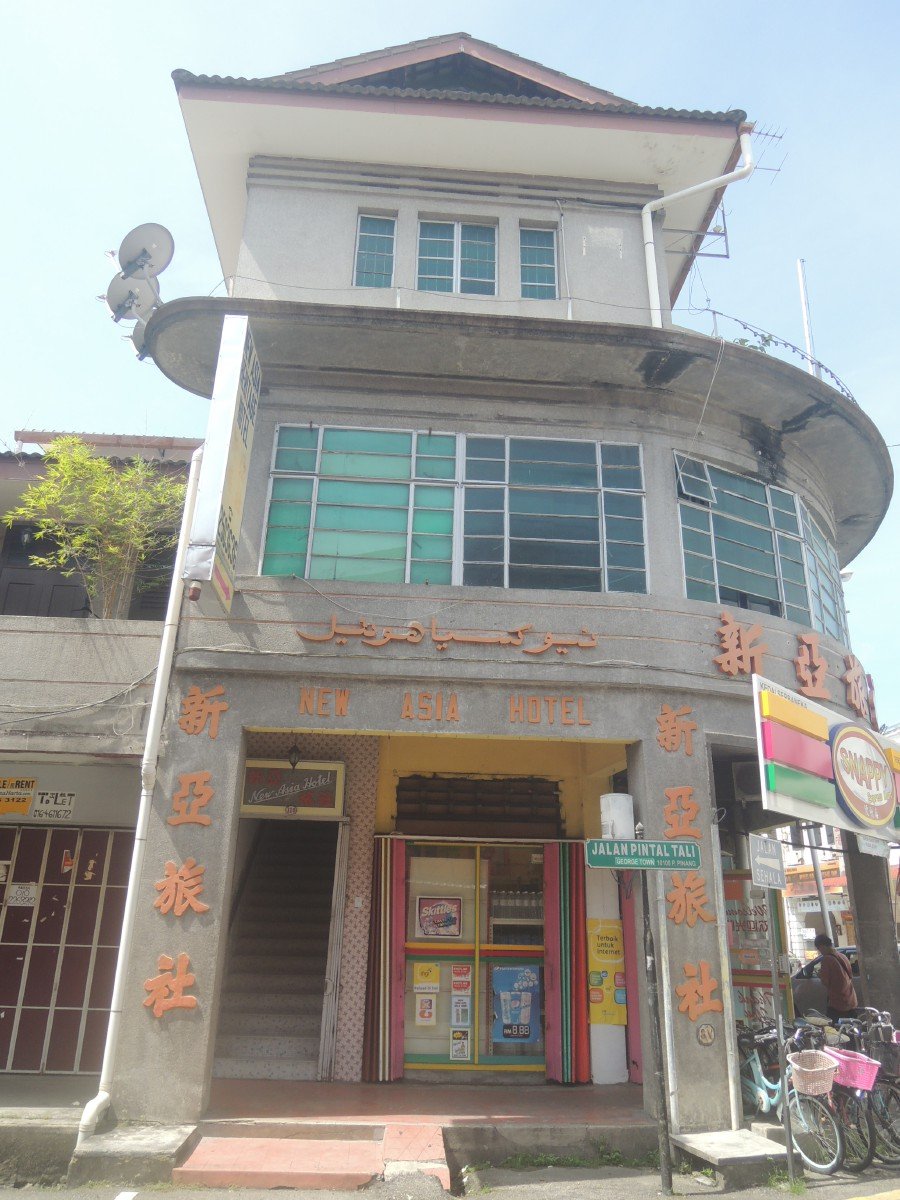
New Asia Hotel is located at the junction of Rope Walk and Lebuh Kimberley.
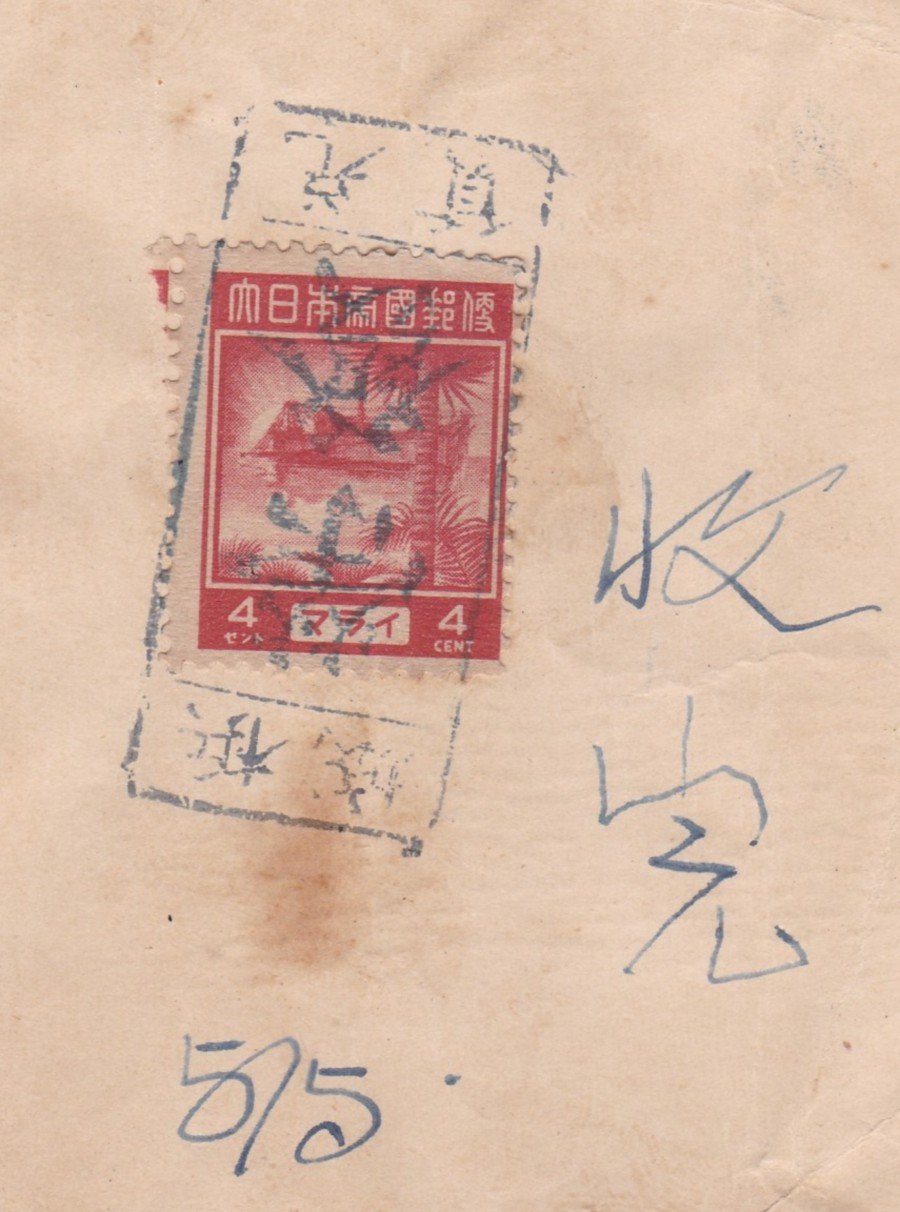
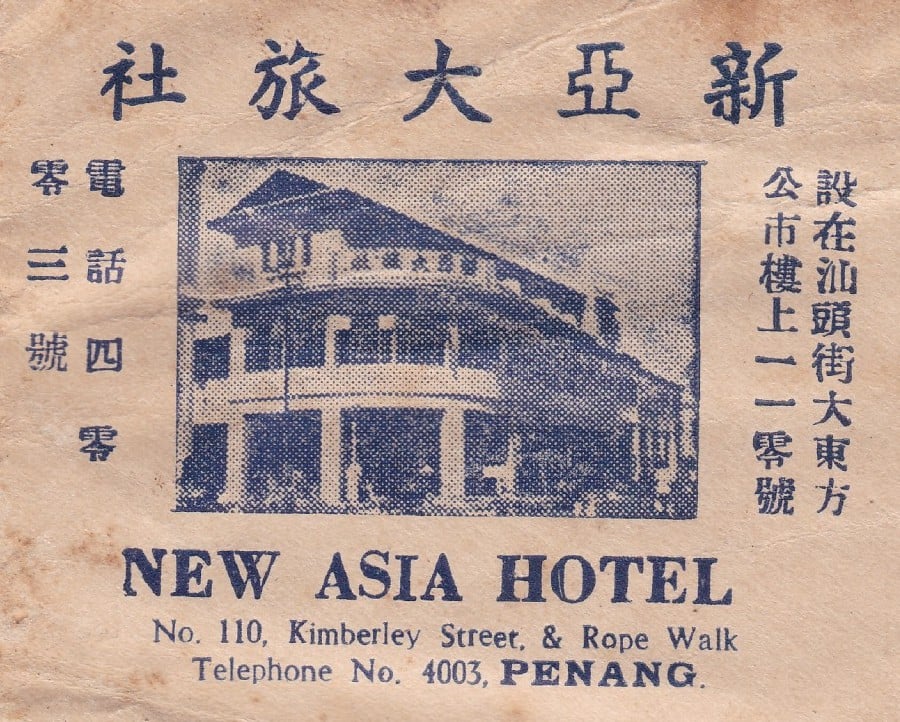
CHECKING THE 'LOOT'

TRACKING THE STORY

REIGN OF THE JAPANESE
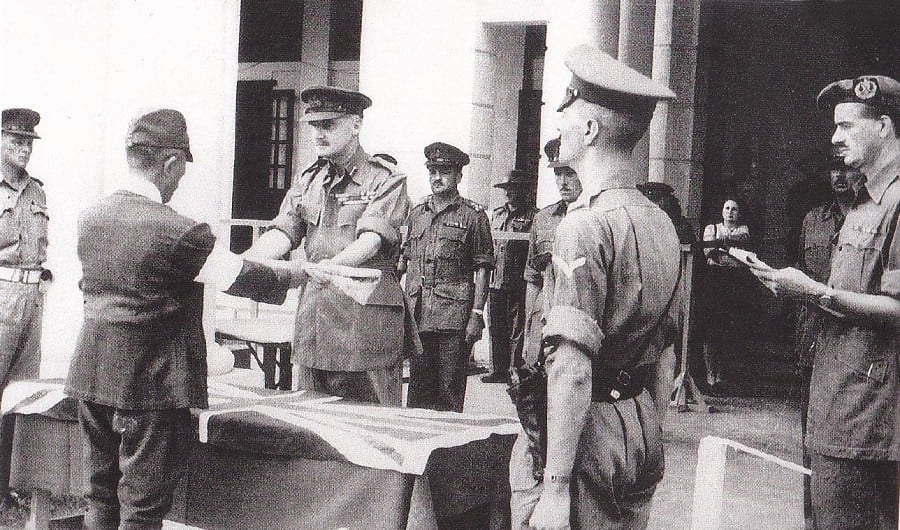
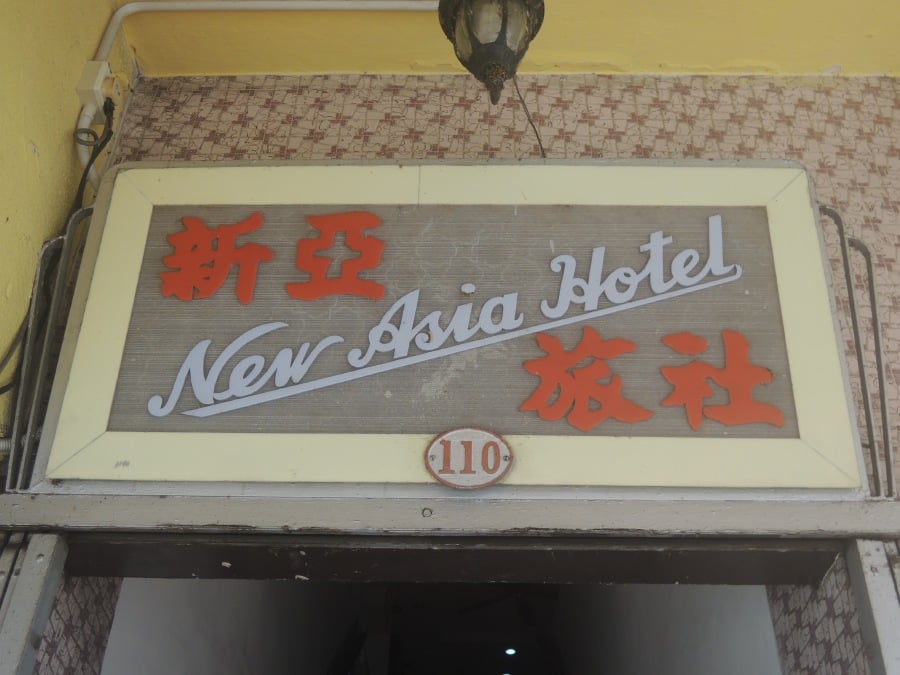
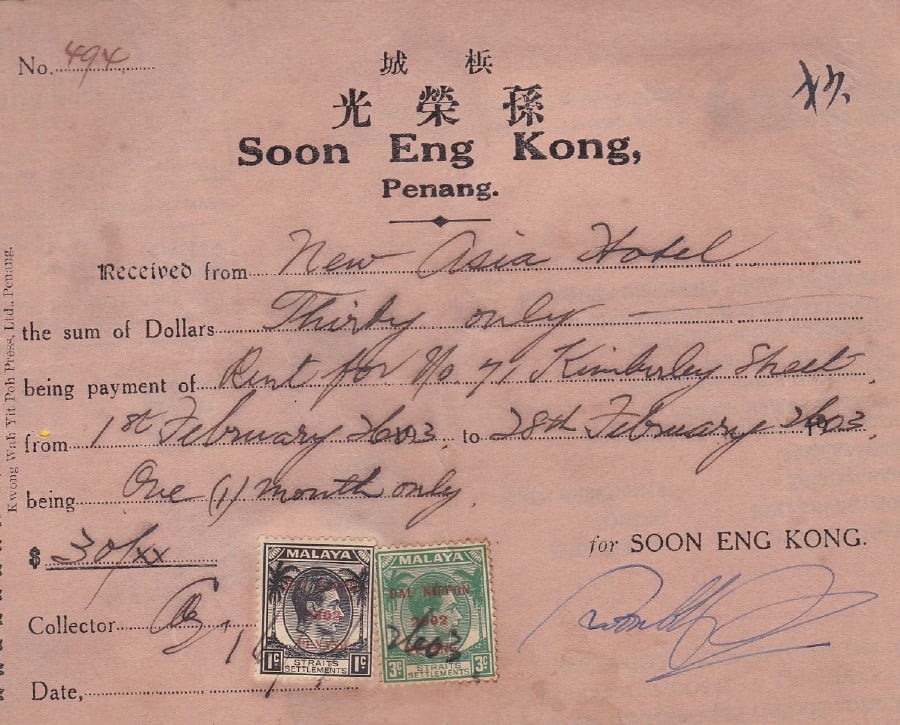
Written by : Alan Teh Leam Seng
Link https://www.nst.com.my/lifestyle/sunday-vibes/2018/01/322538/revisiting-penangs-tumultuous-past
IMBAS KEMBALI SEJARAH PULAU PINANG YANG KACAU BILAU
Lawatan ke Pasar Lambak di Padang Brown memberi kesempatan kepada penulis mengkaji lebih banyak mengenai era Jepun di Pulau Pinang.
MELIHAT BARANGAN

Sekeping resit cukai dengan kadar cukai sebanyak 4 sen
MENJEJAKI KISAH


New Asia Hotel terletak di simpang Jalan Pintal dan Lehuh Kemberley

"Kami tidak menyimpan sebarang rekod lama. Semuanya telah dibersihkan oleh pemilik lama sebelum kami mengambil alih. Kami ada melakukan sedikit kerja-kerja pengubah suaian pada 2010 tetapi seingat saya, kami tidak menemui apa-apa barangan berkaitan sejarah silam hotel ini" beliau menjelaskan apabila saya menunjukkan kepadanya barangan yang saya beli. Pemintaan saya untuk menghubungi pemilik asal turut menemui jalan buntu.
PEMERINTAHAN JEPUN


Secara beransur-ansur, seawal bulan November 1944, arus peperangan mula memberi masalah kepada Jepun apabila pasukan pengebom tentera Bersekutu mula tiba di Pulau Pinang dan mengebom tempat-tempat penting.

PEPERANGAN BERAKHIR

Diterjemah oleh : Teratai Melur

New Asia Hotel is located at the junction of Rope Walk and Lebuh Kimberley.
A visit to the Padang Brown flea market turns out to be an opportunity for the writer to learn more about the Japanese Occupation in Penang
"Documents! That vendor over there just pulled out a large bag of old documents!" my wife whispers excitedly into my ear just as I'm about to start sifting through a stack of old picture postcards. She waves her finger towards the opposing side of the narrow pathway filled with people. I looked intently but fail so see the seller. The look on her face, however, tells me that something is afoot. Placing the stack of cards in her hands, Iquickly head off in search of the elusive seller.
It's only 4pm but the afternoon flea market at Padang Brown is already in full swing. Dozens of vendors start gathering at this spot in Penang's bustling Dato Keramat area as soon as they're done with lunch.
It's only 4pm but the afternoon flea market at Padang Brown is already in full swing. Dozens of vendors start gathering at this spot in Penang's bustling Dato Kramat area as soon as they're done with lunch.
Suddenly, I catch sight of a large group crowding around a man standing beside a motorcycle. The seller keeps on dipping into a large gunny sack and placing rolls of paper into the outstretched hands of the buyers. I quicken my steps and join in the action, putting all I can get my hands on into a plastic bag. There's no time to check anything. My aim is to secure as many things as possible and only check them when time permits.

An interesting tax receipt paying the 4 cents rate.
"Japanese Occupation!" These words keep ringing out as buyers delightedly peek at their new found possessions. Tempers occasionally flare when some people start vying for the same items. Fortunately, they cool down when more appear from the seemingly bottomless bag.
Finally, the seller announces that the stack f envelopes in his right hand represents the last of the lot. I Join the crowd in lunging forward with gusto. To my delight, my effort is richly rewarded when the envelopes are shoved into my waiting palm.
The crowd slowly thins, leaving the buyers to start paying the seller for their purchases. Soon my turn arrives and the seller merely peeks into my bulging plastic bag and holds it in his hands to make a rough estimation of its weight before quoting his price.

CHECKING THE 'LOOT'
Back in the car, my wife and I excitedly start going through the items. A lot of stuff turns out to be rolled up rental receipts for New Asia Hotel located at the junction of Rope Walk (now Jalan Pintal Tali) and Lebuh Kimberley.
The dates on the receipts range from 1940 to 1945 and each receipt is affixed with a duly cancelled 4c stamps. That's the correct tax rate for receipts back then. Apart from some Straits Settlement stamps, the bits of fragile paper mostly bear adhesives from the Japanese Occupation period.
Disappointment starts to creep as I unearth more common receipts. Then I decide to check the contents of the stack of envelopes. An avalanche of goodies start to appear. These include Japanese Occupation era lotteries tickets, photographs, letters, newspaper cuttings, bank fixed deposit statements and a small number of early luggage labels produced by the hotel.
A myriad of questions start surfacing as soon as I reach the end of the pile. "Does this hotel still exist today? Could there be more of these priceless items in the storeroom waiting to be discovered?" I ask myself. That feeling of wanting to make a quick drive to the address to find out more begins to nag. In my heart I harbour the hope of meeting the owner, and with some luck, learn his story.

TRACKING THE STORY
The George Town traffic is surprisingly light for a late Thursday afternoon. I can barely contain my excitement and before long, I spot the New Asia Hotel signboard. My first question has already been answered. "This is a good sign. Hopefully we'll get to meet the owner," I tell my wife as we start walking up the flight of stairs leading to the reception area on the first floor.
My hopes are dashed a few minutes later as I learn from the manager on duty that his company had taken over management of the hotel about seven years ago when the previous owner decided to call it a day.
"We don't have any of the old records. Everything was cleared out by the previous owner before we took over. We did some minor renovations in 2010 but as far as I can remember we didn't find anything related to the hotel's past," she explains when I show her the things I'd bought. My request to contact the former owner draws a blank as well.
My only consolation is her generous permission to look around the place. Looking out at the bustling junction down below through an open window, I can just imagine the sight that must have greeted Penangites when the triumphant Japanese soldiers, astride their tanks, rumbled for the first time into town. The minds of the people at the time must have been fraught with concern, fearful of their bleak future under the aggressors from the Land of the Rising Sun

Reign of the Japanese
The Japanese Military Administration in Penang began on Dec, 17, 1941. Right from the start, the Chinese community was singled out to bear the burnt of their oppression. This was their way of getting back at the locals for supporting the war effort back in China ever since the Japanese Army started their incursions there in 1937.
One of the most potent measures used by the Japanese to intimate the Chinese was summary execution by beheading. In just a few days after the occupation, severed heads were placed at key intersections all over George Town. This action, apart from eliminating the people who are most likely to cause trouble, undoubtedly had a salutary effect on the rest of the population.
Referring to the newspaper cuttings of the Penang Shimbun, a local Japanese controlled daily, I learn that the Japanese secret police or Kempeitai began detaining Chinese community leaders who'd been actively supporting the Chungking government and the Chine Relief Fund. Apart from that, mass investigation of the entire Chinese population were conducted with the sole purpose of 'purification by elimination'.

The Japanese officially surrendered on Sept 5, 1945 in Penang
On April 5, 1942, the people were told to gather at various centres throughout George Town. Screening were conducted with the help of masked informers who identified people according to four categories: those who'd worked against Japan, communists, educated individuals and criminals.
As many as 5,000 suspects, of whom a large majority consisted of young and middle aged men, were taken to prison while awaiting further interrogation. A fraction was subsequently released while the rest either died of cholera in the overcrowded cells or were spirited away by the truckloads for execution at deserted beaches on the island.
Apart from physical hardship and mental agony, the local population also suffered when the Japanese authorities froze all their pre-war bank accounts, bringing the local economy to a near standstill. The people were ordered to open new accounts in Japanese-controlled financial institutions like the Yokohama Specie Bank, Bank of Taiwan and the Japanese Konan Bank. The banks only received lukewarm response as the Chinese were unwilling to transact business with the Japanese bank.
Left with no choice, the Japanese authorities ordered the Chinese and Indian banks to resume operations. The Overseas Chinese Banking Corporation, United Chinese Bank, Ban Hin Lee Bank and Lee Wah Bank re-opened in April 1942. The list increased when Southern Bank and Kwong Yik Bank threw their doors open several months later.
All the Japanese and local banks resorted to lotteries and bonuses in the race to attract depositors. The lotteries I found were primarily issued by a branch of the Japanese Konan Bank. A total of 500,000 tickets were produced for each draw. The lottery tickets, at $1 each, gave purchasers the hope of winning the first prize money, which was $50,000. The instructions at the back required winning ticket holders to redeem their prizes at the Yokohama Specie Bank or its authorised branches.

The fixed deposit receipts that I found were of exceptionally large sums of money. Upon close inspection, I notice that the majority of the notes were due in 1946, a year after the Japanese Occupation ended. The owner must have lost a fortune as the British demonetised all war time currency when they returned to Penang!
The tides of war began to slowly turn against the Japanese as early as November 1944 when Allied bombers began appearing over Penang and initiated bombing runs on important installations.
This prompted the jittery shopkeepers in Penang to close their shops in anticipation of further attacks. The Penang Shimbun reported on Nov 15, 1944 that the head of the Kempeitai issued warnings to shopkeepers telling them that premises which fail to open would be sealed for an indefinite period of time.
An attack on Jan 11, 1945 destroyed government buildings, the post office and important structures near the waterfront. A day after a massive raid on Feb 1, the entire George Town fell silent. Many of its residents opted to either remain indoors or flee for the suburbs where they were less likely to be hit.

One of the more interesting Japanese Occupation-era receipts
End of the war
Japan finally surrendered on Aug 15, 1945. British naval forces left their base in Sri Lanka’s Trincomalee port for Penang that very same day while the swifter minesweepers left Colombo three days later to clear the Melaka Straits. The naval flotilla planned to arrive in Penang on Aug 21. However, just before reaching Malayan waters, the Commander on board received instructions to delay his arrival to allow time for the surrendering Japanese commanders to effectively disseminate their cease-fire orders.
The British finally arrived in Penang on Sept 3 but they were forced to delay their landing for a further 24 hours when the local Japanese commander requested for more time to evacuate his forces to the mainland. A formal re-occupation ceremony took place on Swettenham Pier on Sept 5, 1945.
My last document dates to just a few days before this momentous ceremony took place. The previous owner of the hotel must have been relieved to learn that the war had finally ended. The return of the Allied forces must have given him the security to dispense with further record keeping.
As for me, I’m glad to possess a tiny slice of our nation’s history that will remind me of a time when peace was a just a distant memory.
The atrocities suffered during the Japanese Occupation serve as a grim reminder to all of us to treasure the peaceful way of life that we enjoy now. Let us all pray that our wonderful nation will never have to witness such terror again.
Link https://www.nst.com.my/lifestyle/sunday-vibes/2018/01/322538/revisiting-penangs-tumultuous-past
IMBAS KEMBALI SEJARAH PULAU PINANG YANG KACAU BILAU
Lawatan ke Pasar Lambak di Padang Brown memberi kesempatan kepada penulis mengkaji lebih banyak mengenai era Jepun di Pulau Pinang.
Dokumen! Kat sana ada penjual baru keluarkan beg besar penuh dengan dokumen!. Isteri saya membisik ke telinga saya dengan gembira ketika saya hendak mula melihat susunan gambar lama poskad. Dia menunjuk ke arah lorong kecil bertentangan yang telah dipenuhi orang. Saya cuba melihat penjual yang dimaksudkannya tetapi gagal melihatnya. Akan tetapi, raut wajah isteri saya memberitahu ada sesuatu sedang berlaku. Saya meletakkan susunan poskad dalam tangannya dan bergegas mencari penjual yang sukar dilihat itu.
Jam menunjukkan pukul 4 petang namun pasar lambak petang di Padang Brown sudah dipenuhi orang ramai. Berdozen-dozen penjual mula berkumpul di tapak kawasan sibuk Dato Keramat di Pulau Pinang setelah menjamu selera makan tengah hari.
Tiba-tiba saya ternampak sekumpulan orang ramai mengerumuni seorang lelaki yang sedang berdiri sebelah sebuah motosikal. Penjual itu sedang mengeluarkan barangan daripada guni besar dan meletakkan gulungan kertas pada tangan pembeli. Saya mempercepatkan langkah saya dan menyertai mereka lalu memasukkan gulungan kertas ke dalam beg plastik. Tiada masa untuk melihat. Sasaran adalah mendapatkan sebanyak mungkin dan melihat barangan ini kemudian.
"Zaman Jepun!" Perkataan ini mula kedengaran apabila pembeli melihat barangan baru mereka. Sekali-sekala perasaan marah boleh kelihatan apabila beberapa pembeli mahukan barangan sama. Nasib baik, keadaan mula reda apabila lebih banyak barangan dikeluarkan daripada guni.
Akhirnya, penjual tersebut mengumumkan susunan sampul surat di tangannya kanannya ialah barangan terakhir. Saya menyertai kumpulan pembeli yang mula merapati penjual itu. Saya merasa gembira apabila sampul surat itu diletakkan pada tangan saya.
Kumpulan pembeli mula berkurangan meninggalkan tempat jualan dan membayar untuk barangan mereka. Apabila tiba giliran saya, penjual tersebut melihat secara imbas beg plastik yang penuh dan mengangkat bagi menganggar secara kasar berat kandungan sebelum memberikan harganya.
MELIHAT BARANGAN
Setelah kembali ke kereta, saya dan isteri saya mula melihat barangan yang dibeli dengan perasaan teruja. Kebanyakkan barangan adalah gulungan resit sewa Hotel New Asia yang terletak di simpang Rope Walk (Jalan Pintal Tali) dan Lebuh Kemberley.
Tarikh pada resit-resit tersebut bermula dari 1940 hingga 1945 dan setiap resit ditampal dengan setem 4c yang dibatalkan. Ia adalah kadar cukai untuk resit pada masa itu. Selain daripada beberapa keping setem dari era Penempatan Selat, kertas lusuh ini mempunyai kesan dari zaman Jepun.

Sekeping resit cukai dengan kadar cukai sebanyak 4 sen
Perasaan kecewa mula menyelubungi saya apabila melihat semakin banyak resit sama. Kemudian, saya mengambil keputusan untuk melihat kandungan sampul surat pula. Bertimbun-timbun barangan berharga mula muncul. Ini termasuk tiket loteri era Jepun, foto-foto, surat-surat, kepingan surat khabar, penyata deposit tetap bank dan beberapa keping label beg pakaian terawal yang dikeluarkan oleh hotel tersebut.
Apabila saya telah melihat kandungan terakhir susunan sampul surat, pelbagai soalan mula muncul dalam fikiran saya. "Adakah hotel ini masih berfungsi? Adakah lagi barangan berharga sedang menunggu untuk diteroka di bilik setor?' Saya bertanya soalan ini pada diri saya. Perasaan ingin singgah ke lokasi ini bagi merungkai lebih banyak persoalan mula dirasai. Dalam hati saya, saya berharap agar dapat menemui pemilik hotel dan sekiranya bernasib baik dapat mengetahui kisahnya.
Trafik di George Town pada petang Khamis agak ringan. Saya tidak dapat menyembunyikan kegembiraan saya apabila saya melihat papan tanda New Asia Hotel. Soalan pertama saya terjawab. "Ini petanda baik. Harap-harap kita dapat berjumpa dengan pemiliknya," Saya memberitahu isteri saya sambil menaiki tangga menuju ke bahagian sambut tetamu di tingkat pertama.


New Asia Hotel terletak di simpang Jalan Pintal dan Lehuh Kemberley
Harapan saya berkecai beberapa minit kemudian apabila dikhabarkan oleh pengurus hotel bertugas bahawa syarikat baharu ini mengambil pengurusan hotel ini sejak tujuh tahun dahulu apabila pemiliknya mahu menjual hotel ini.

Kebenaran beliau untuk saya melihat bahagian dalam hotel menyenangkan hati saya. Melihatkan suasana sibuk di simpang menerusi tingkap terbuka, saya dapat membayangkan bayangan yang dilihat oleh rakyat Pulau Pinang apabila kemenangan tentera Jepun bercelapak kereta kebal mereka memasuki bandar ini buat pertama kali. Fikiran mereka sudah pasti penuh dengan ketegangan bercampur baur dengan kerisauan, takut akan masa depan gelap di bawah penceroboh dari Negara Matahari Terbit.
Pentadbiran Ketenteraan Jepun bermula di Pulau Pinang pada 17 Dis 1941. Sejak awal lagi, komuniti Cina diasingkan bagi menerima padah yang paling hebat iaitu penindasan ke atas mereka. Ini cara Jepun membalas dendam kepada mereka kerana menyokong perang di China sejak Tentera Jepun memulakan serangan mendadak di China pada 1937.
Salah satu tindakan keras yang digunakan oleh tentera Jepun untuk menakutkan orang Cina adalah menjatuhkan hukuman pancung. Hanya beberapa hari setelah menawan Pulau Pinang, kepala-kepala yang dipancung diletak di seluruh persimpangan George Town. Selain daripada menghapuskan mereka yang mungkin menimbulkan masalah, tindakan ini turut menjadi pengajaran kepada seluruh warga Pulau Pinang.
Merujuk kepada keratan akhbar, Penang Shimbun, surat khabar tempatan yang dikawal oleh Jepun, saya mendapati polis rahsia Jepun atau Kempetai mula menangkap ketua komuniti-ketua komuniti Cina yang aktif menyokong kerajaan Chungking dan Tabung Kemanusiaan China. Selain itu, penyiasatan besar-besaran dilakukan ke atas populasi Cina dengan satu tujuan iaitu 'penyucian menerusi pembersihan'.
Pada 5 April 1942, penduduk Pulau Pinang disuruh berkumpul di pelbagai pusat perkumpulan di George Town. Saringan dilakukan dengan bantuan pemberi maklumat bertopeng bagi mengenal pasti penduduk mengikut empat kategori; mereka yang menentang Jepun, komunis, individu berpelajaran dan penjenayah.
Seramai 5,000 suspek, majoriti pemuda dan lelaki pertengahan umur dibawa ke penjara untuk disoal siasat. Hanya sebilangan kecil dibebaskan sementara ada yang mati disebabkan oleh kolera kerana ditempatkan dalam sel penjara sesak atau dibawa dalam trak untuk dibunuh di pantai terpencil pulau.

Selain daripada beban fizikal dan penderitaan mental, penduduk tempatan merana apabila pentadbiran Jepun membekukan kesemua akaun bank sebelum perang. Ini menyebabkan ekonomi tempatan hampir terhenti. Penduduk diarahkan membuka akaun baharu di institusi kewangan yang dikawal oleh Jepun seperti Yokohama Specie Bank, Bank of Taiwan dan Japanese Konan Bank. Bank-bank ini tidak begitu mendapat sambutan kerana orang Cina enggan melakukan transaksi dengan bank-bank Jepun.
Disebabkan tiada pilihan, pentadbiran Jepun mengarahkan bank-bank Cina dan bank-bank India memulakan semula operasi. mereka. The Oversea Chinese Banking Corporation, United Chinese Bank, Ban Hin Lee Bank dan Lee Wah Bank dibuka semula pada bulan April 1942. Beberapa bulan kemudian, Southern Bank dan Kwong Yik Bank turut dibuka semula.
Kesemua bank-bank Jepun dan bank-bank tempatan mengadakan cabutan loteri dan memberikan bonus bagi menarik pelanggan. Tiket loteri yang saya temukan dikeluarkan oleh cawangan Japanese Konan Bank. Sebanyak 500,000 keping tiket dihasilkan bagi setiap cabutan. Tiket loteri berharga $1 sekeping memberikan harapan kepada pembeli untuk memenangi hadiah pertama bernilai $50,000. Arahan tertera di bahagian belakang loteri meminta pemenang loteri menebus hadiah mereka di Yokohama Specie Bank atau di cawangan-cawangan bank yang diberi kuasa.
Resit deposit tetap yang saya temukan menawarkan jumlah wang yang sangat besar. Apabila diteliti, saya dapati tarikh luput pada kebanyakan resit berakhir pada 1946, setahun setelah Pendudukan Jepun berakhir. Pemilik resit ini pasti mengalami kerugian kerana pihak British mengharamkan semua mata wang era peperangan apabila pulang semula ke Pulau Pinang!

Secara beransur-ansur, seawal bulan November 1944, arus peperangan mula memberi masalah kepada Jepun apabila pasukan pengebom tentera Bersekutu mula tiba di Pulau Pinang dan mengebom tempat-tempat penting.
Ini membuatkan pemilik-pemilik kedai merasa gementar lalu menutup kedai mereka sambil menunggu serangan seterusnya. Pada 15 Nov 1944, surat khabar Penang Shimbun melaporkan, ketua Kempetai mengeluarkan amaran kepada pemilik-pemilik kedai agar membuka semula perniagaan mereka dan sekiranya mereka gagal berbuat demikian, perniagaan mereka akan ditutup selama-lamanya.
Serangan pada 11 Jun 1945 telah memusnahkan bangunan-bangunan kerajaan, pejabat pos dan struktur-struktur bangunan penting berhampiran kawasan dermaga. Sehari selepas serangan besar-besaran dilancarkan pada 1 Feb, seluruh bandar George Town menjadi sunyi sepi. Ramai penduduk memilih sama ada duduk di dalam rumah atau melarikan diri ke subbandar bagi mengelak diserang.

Akhirnya, Jepun mengerah kalah pada 15 Ogos 1945. Pada hari yang sama, angkatan tentera laut British bertolak ke Pulau Pinang dari pangkalan tentera di pelabuhan Trincomalee, Sri Lanka. Kapal penyapu periuk api yang lebih pantas meninggalkan Colombo tiga hari kemudian bagi membersihkan Selat Melaka. Flotila tentera itu telah merancang untuk tiba di Pulau Pinang pada 21 Ogos. Namun, ketika menghampiri perairan Malaya, Komander bertugas menerima arahan agar melewatkan ketibaan mereka bagi memberikan masa kepada komander-komander Jepun menyerah diri dan meyebarkan arahan gencatan senjata secara berkesan.
Akhirnya, tentera British tiba di Pulau Pinang pada 3 Sept tetapi terpaksa menangguhkan ketibaan mereka selama 24 jam lagi apabila komander Jepun bertugas meminta lebih banyak masa bagi memindahkan tenteranya dari tanah besar. Acara penempatan semula rasmi diadakan di Swettenham Pier pada 5 Sept 1945.

Tentera Jepun menyerah secara rasmi di Pulau Pinang pada 5 Sept, 1045
Tarikh-tarikh yang tertera pada dokumen terakhir adalah tarikh beberapa hari sebelum upacara penyerahan diadakan. Pemilik terdahulu hotel ini pasti lega apabila perang telah berakhir.
Sekembalinya pasukan Bersekutu memberikan beliau peluang untuk menyimpan dokumen ini sebagai rekod.
Bagi saya, peluang untuk memiliki secebis sejarah negara kita yang mengingatkan saya akan zaman ketika keamanan adalah satu memori.
Kekejaman peperangan dialami ketika zaman Jepun umpama peringatan kepada kita agar menjaga keamanan yang kita miliki. Ayuh kita berusaha agar negara kita tidak akan menyaksikan ketakutan seumpama itu.
Comments
Post a Comment